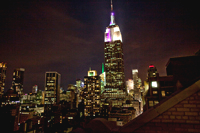
by Shane Henson — May 16, 2012—Philips Color Kinetics, a provider of professional LED (light-emitting diode) lighting systems in a multitude of types, form factors, and output levels, has been tapped to transition the Empire State Building’s (ESB) iconic tower lights to innovative LEDs that are sure to awe both Manhattan’s tourists and residents.
The state-of-the-art dynamic lighting system from Philips Color Kinetics is unique to the Empire State Building and will allow the building’s façade and mast to change lighting scenes in real time. In addition to greater control and management of the lighting, the new system will deliver the superior light levels for the design, as well as allow the ESB to highlight its architectural details.
The ESB celebrates many cultures and causes in the world community with iconic lightings. Its tower lights recognize key milestones, events, charitable organizations, countries, and holidays, a tradition started in 1932 when a simple searchlight was used to announce the election of New York-born Franklin Delano Roosevelt as president. To honor the United States Bicentennial, the ESB installed colored floodlights to illuminate the building at night, lighting up red, white and blue, leading to today’s very popular Lighting Partner program. The new Philips LED lighting system will help to enhance this program by making each lighting more unique and special, the company says.
The Empire State Building is replacing its traditional light fixtures with LEDs as part of its 21st century renovation. The new computerized system will allow customized light capabilities from a palette of more than 16 million colors, including hard-to-achieve pastels, in virtually limitless combinations. The LED lights will replace the current palette of 10 colors, which also requires a team several hours to change the building’s nearly 400 fixtures. Soon the ESB staff will be able to create and update customized lights, using new energy-efficient technology.
Moreover, using Philips Color Kinetics LED lighting technology will make it possible to control and focus the light exactly where and how the effect is desired. Ripple, cross-fade, and particle and burst effects, previously not possible, can be easily automated to create unique lighting designs. The new Philips lighting system will also allow the building to minimize light spill, ensuring that light is focused on the façade and mast, while providing enough light to allow the building to be seen from anywhere in New York City. This feature not only respects the night sky, but the building’s neighbors as well.





